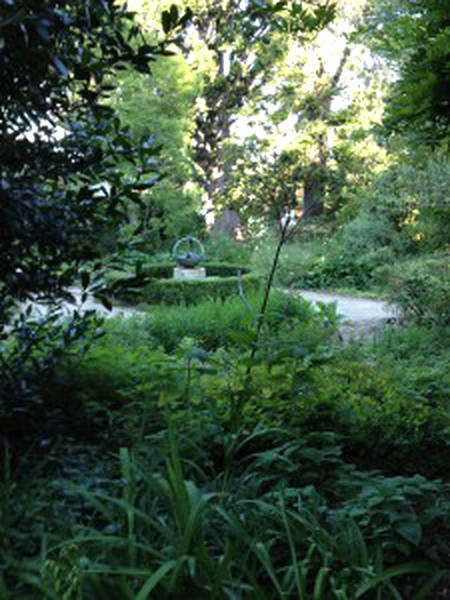I remember Mrs Carbury in her motorised wheelchair, the vehicle that provided mobility within her small bed-sitter and beyond into her large organic vegetable and herb garden.
The small dwelling, built to accommodate her special needs, was adjacent to a larger dwelling occupied by her daughter, son-in-law and their children, and these two abodes in turn were situated at the rear of a large property in Barkers Road, Hawthorn, an older eastern suburb of Melbourne. The property, which was across the road from Preshil, “The oldest progressive school in Australia”, had been one of the grand estates of early Melbourne.
The two storey Victorian mansion in which Mrs Carbury had lived as a girl was still present — the two smaller dwellings being nestled behind it at the lower end of the property. It may seem strange to modern Melbournians, but in the era about which I write — the mid 1970s — such grand old houses were not sought after the way they are today. Consequently Mrs Carbury’s childhood home had fallen into disrepair and been relegated to duty as a rooming house for students.
A landholding of perhaps an acre or two framed the big house. In front of the big house was the disused formal driveway that would once have witnessed the arrival of horse-drawn carriages. Along the western side was a service road which led around to the rear of the big house. There was an old and disused tennis court in the north-eastern corner. The property was well-populated with trees old and new and had a somewhat overgrown and disheveled ambience.
But of relevance to my connection with Mrs Carbury was the large herb and vegetable garden along the eastern boundary.
My introduction to Mrs Carbury came via Peter Cock, a lecturer at Monash University whom I had met through the university “Communal Living Society”, which never did any communal living but did have an organic vegetable garden on land owned by the university in South Clayton. Peter Cock’s father, Hainsworth Cock, was a naturopath and Biodynamic farmer, and Mrs Carbury was one of his patients. Through this connection, a visit of the student group to Mrs Carbury’s garden had been arranged.
Afterwards I began making my own visits, usually on a Saturday or Sunday afternoon, to assist in the garden and learn about organic gardening, herbs, and related topics. Getting there from East Malvern where I lived required a journey by train to Gardiner station followed by a tram ride up Burke Road to Barkers Road, then a short walk down the hill to Mrs Carbury’s.
Visits were arranged in advance by telephone. There were two ways into the property — either via the driveway beside the big house or via a laneway which ran from Harcourt Street into the rear of the property.
An afternoon would typically begin with some conversation in Mrs Carbury’s small house.
Then we would move outside to work in the garden. I would do the work under Mrs Carbury’s direction — making compost in the large compost bins erected along the side fence, putting mature compost onto the garden beds, weeding, picking vegetables and herbs, planting seedlings, and so on.
Afternoon tea in the house would include biscuits or a cake which I recall was often prepared by Mrs Carbury’s daughter. More conversation would then ensue.
Despite her physical handicaps, and diminutive size, Mrs Carbury had an alert mind that was interested in many things.
It was through these visits that I was introduced to the work of Rudolf Steiner. Mrs Carbury had a collection of Steiner’s books on various subjects. And there were books on Biodynamic farming by Ehrenfried Pfeiffer, a student of Rudolf Steiner and a leading researcher and advocate of Biodynamic agriculture. Pfeiffer influenced J.I. Rodale, the founder of Organic Gardening and Farming magazine, and of the organic movement in the USA. Mrs Carbury was a subscriber to Organic Gardening and Prevention, two periodicals from Rodale Press which also provided material to browse and read during visits.
Looking back, these are the things I learned from my visits to Mrs Carbury:
-
The enjoyment and satisfaction which comes from working in a large, flourishing herb and vegetable garden with its scents and aromas.
-
Appreciation of really fertile organic soils.
-
The value of compost and how to make it.
-
How to pick and dry herbs.
-
Traditions of organic gardening, including the work of Rudolf Steiner and Biodynamics.
-
An appreciation of the rich “other world” of ideas encompassed in the works Rudolf Steiner — not just those about agriculture.
-
The value of a library of good books.
-
How to bake and eat potatoes in their jackets.
The only online reference I could find about Mrs Carbury accompanies a photograph on the website of The Herb Society of Victoria. It is a photo of a bronze water fountain at the Burnley Horticultural College in Melbourne. The caption states:

“This photograph shows the bronze Water Fountain commissioned by the Herb Society of Victoria almost twenty years ago in memory of Enid Carbury a student of the newly founded, in 1873, Burnley Horticultural College and Hank Swaan a former lecturer and researcher of the College. Both were late members of the Herb Society.”